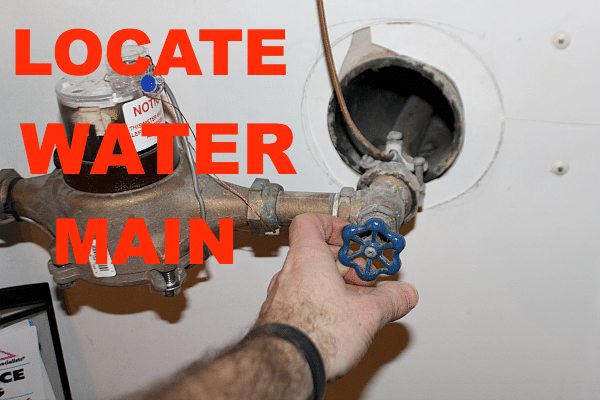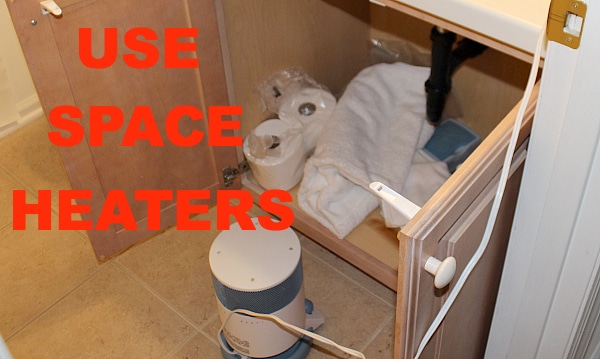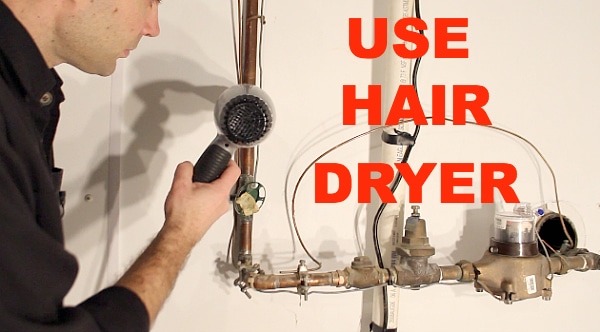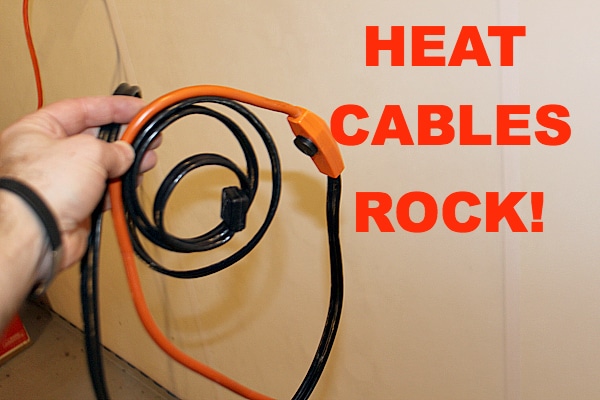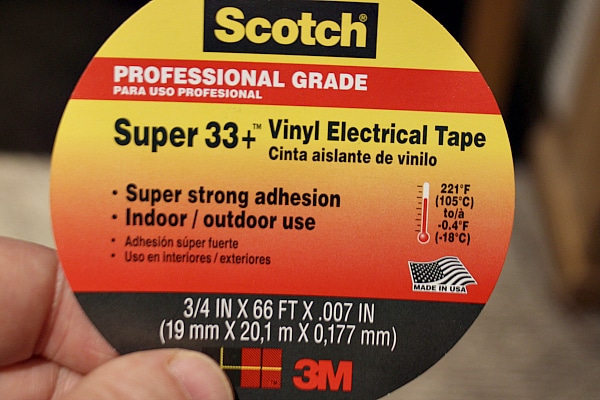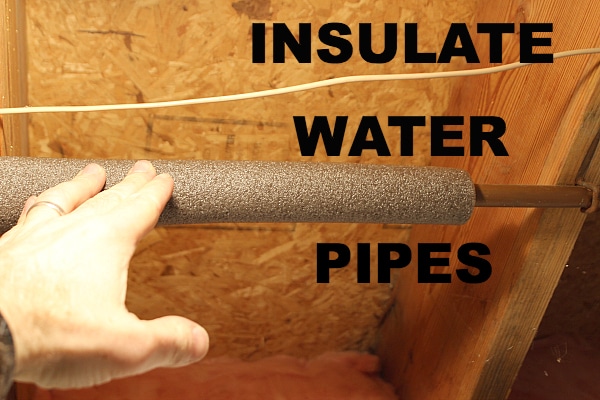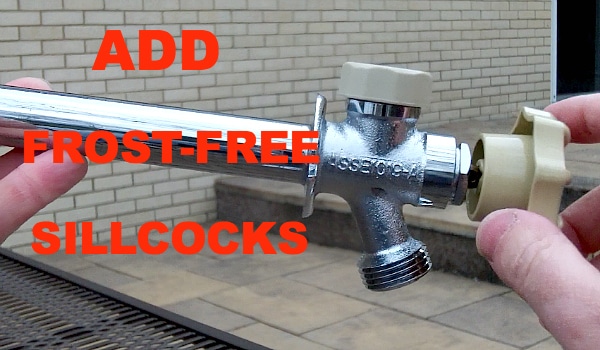This post shows you how to thaw and prevent frozen pipes because when it happens you need to act quickly.
Here’s the deal:
It’s not the freezing part that’s painful. It’s the thawing.
But don’t worry, I have a lot of great tips that’ll help you with your pipes.
Let’s dive in!
Supplies for Thawing Pipes
As a kid, I loved watching shows about science. Especially Mr. Wizard on Nickelodeon (yah, I’m a kid of the 80s and wore parachute pants in 2nd grade).
One thing I learned was that water expands as it freezes.
Frozen water has enough force to make your pipes split or burst.
When this happens and you eventually thaw the pipe you’re going to have water gushing from your ceiling or wall.
Seeing this happen firsthand is like watching a car accident. You can’t believe it’s happening – TO YOU!!!
I’ve been in a bad car crash and have had a water leak from my kitchen ceiling. Both aren’t much fun.
Here’s what you need to thaw and prevent frozen pipes:
- Electrical Heat Cable
- Insulation for Pipe
- Frost-Free Sillcock
- Portable Heater
- Electrical Tape
- Duct Tape
- Extension Cord
- Heat Gun
- These Amazon links help support Home Repair Tutor, thanks for using them
Let’s get started and help you become a DIY Superhero!
Figure Out Where the Pipes are Frozen
At one point this year it was -20F here in Pittsburgh.
Why do I remember? That’s the day one of my tenants texted me to say the tub and toilet pipes were frozen!!!
Fortunately, she is AWESOME and knew exactly what to do.
The pipes froze in her bathroom because they run along an exterior wall.
How did my tenant get the pipes unfrozen?
First, she’s a smart cookie and has dealt with it before (although not at my house).
Secondly, I gave her some additional advice that I’ll share with you today.
If your pipes freeze you should first locate the water main.
It comes into the house from the street and is likely in a basement or garage.
Water mains come in through the side of the house and then supply the rest of your home’s pipes.
When temps get below a certain point, pipes that run along an exterior wall are more likely to freeze than pipes that run inside interior walls.
So, it makes sense to begin your search for frozen pipes by starting at the water main and follow the pipes along all exterior walls.
Here’s the deal:
Frozen pipes often times (not always though) have frost on them. Keep your eyes peeled for this clue.
Follow your pipes and turn on faucets or flush toilets. If the faucet or toilet doesn’t run then you know the preceding pipe run has an ice clog in it.
This takes some deductive reasoning and a little Magnum P.I. detective work.
This was my New Years’ costume.
I love Magnum P.I.
Once you find your frozen pipe it’s time to thaw it out.
THAWING YOUR FROZEN PIPES
There are a few different ways to thaw your pipes.
First, if you don’t have water running to your bathroom or kitchen faucets make sure to open up the cabinet doors.
This allows heat from the home to warm up the pipes.
Secondly, place a space heater in front of the cabinet. Plug it into a GFCI and turn it onto the warmest settings.
This will speed up the thawing process. And trust me, you want there to be urgency involved.
If the water in your pipes freezes too much it will expand inside the pipe. And like I said at the beginning this could cause the pipe to split. Ice can also make soldered fittings come loose.
All this is bad news that could lead to a leak inside your wall. Think about how much a pain that would be. Now you’d have to remove a section of pipe along with some drywall.
If you can stand it, turn up the heat in your house as well. This will protect your pipes from freezing more. Sure, your heating bill will be high but I’d rather pay a few extra bucks for my heating bill than deal with water leaks.
You can also use a hairdryer or heat gun to thaw any visible pipes that have frozen. Apply the heat on the side of the pipe that’s closest to the water source.
You’ll want to do this so that as the pipe thaws out the water pressure from the water main will push the ice buildup through the pipe.
Oh, I almost forgot. As you’re thawing pipes make sure the faucet closest to the clog is turned on. This helps the process.
I hope that makes sense. You can always ask me your question in the comments in case you’re scratching your head.
Hopefully, this section helps you with your frozen pipes. But how do you prevent this from happening in the first place?
HOW TO PREVENT FROZEN PIPES: 3 SOLUTIONS TO HELP YOU OUT
You can do a preemptive strike to prevent frozen pipes.
And it won’t cost you a boatload of money.
Certainly, open your cabinet doors and apply heat from a space heater if you suspect your pipes might freeze.
This will help a TON.
One of the best solutions out there for preventing frozen pipes is to use electrical heat cables.
These little devices plug into a standard 120V outlet and heat up when the pipes drop to a certain temperature.
Follow the directions that come with the heating cable and you’ll be set.
The one I bought from Lowe’s came in 6ft and 12ft sections.
It had to be attached to the pipe without any overlap or spiraling. Otherwise, the cable would overheat.
You’ll want to use electrical tape to attach the heating cable to the pipe. But make sure your tape has the appropriate heat rating.
The heating cable I bought required the heat rating to be at least 176F. Being an overachiever, I got a tape with a 221F rating.
Once spring arrives you can simply unplug the heating cable until the fall season comes around again.
Check out this video to see exactly how easy it is to use these cables.
The second action you can take is to add foam insulation to your pipes. This will help out immensely and it’s easy to do.
Simply separate the slit on the insulation and place it on your pipes. Once you’re satisfied with the positioning make sure to seal the slit by placing duct tape on it. This will preserve the R-Value of the insulation and keep your pipes cozy.
Finally, it’s a great idea to replace all exterior hose bibs with frost-free sillcocks.
These little babies will keep your hose bibs from turning into ice cubes.
And you can use SharkBite push on fittings to make all the plumbing connections.
Here’s the deal, I didn’t replace several hose bibs at my rentals and was nervous as all heck when the temps went below freezing.
What’s Next
Bathrooms should have GFCI outlets – this is especially important when using portable heaters. We have a great tutorial that shows how to install a GFCI like a pro.
If you’re doing a bathroom remodel and need help, join one of our online courses – they’ll make your bathroom renovation much easier!
Let me know if you have any questions and I’ll do my best to help.
Thanks as always for reading, watching, and being part of our awesome community.
Cheers,
Jeff




